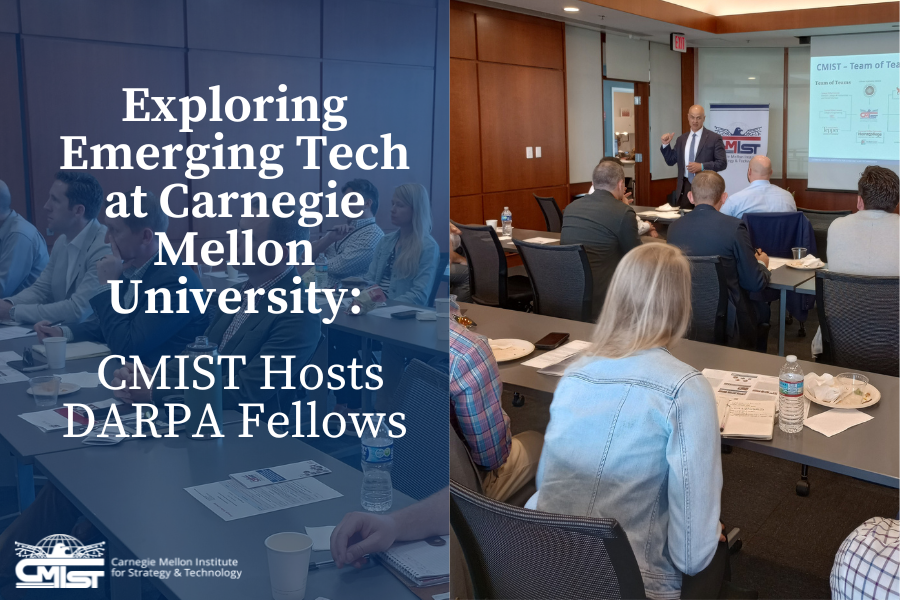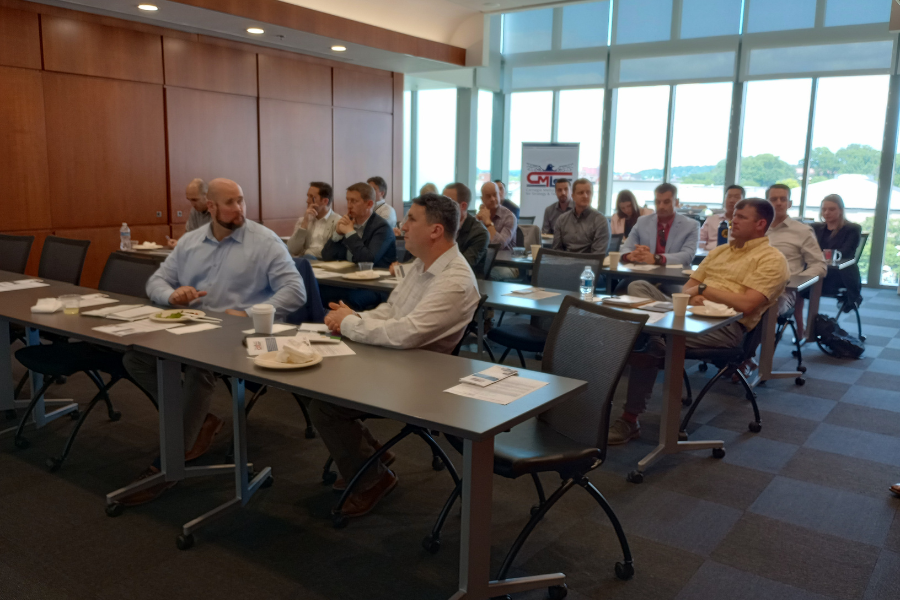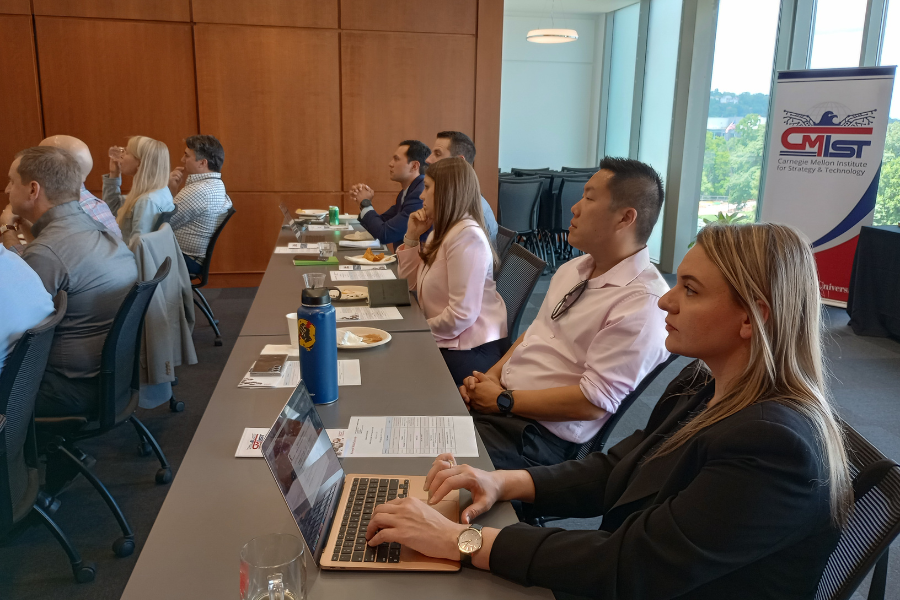
Exploring Emerging Tech at Carnegie Mellon University: CMIST Hosts DARPA Fellows
By Aleksaundra Handrinos
Last month, the Carnegie Mellon Institute for Strategy and Technology (CMIST) hosted thirteen fellows from the Defense Advanced Research Projects Agency (DARPA) for a visit to Carnegie Mellon University (CMU). Fellows had the opportunity to explore emerging technology with a focus on four topics: biorobotics, neural interfaces, software engineering for robotics, and distributed AI. As the research and development agency of the United States Department of Defense, DARPA develops emerging military technologies. To provide military officers and government civilians with insight into cutting-edge science and technology research and introduce them to DARPA's role in supporting DoD missions, DARPA created the Service Chiefs’ Fellows Program. Fellows from the U.S. Navy, Army, Air Force, Space Force, and Marine Corps attended the June 11th visit to CMU.
The day began with a biorobotics discussion by Howie Choset, Kavcic-Moura Professor of Computer Science. Choset's work involves design, motion planning, path planning, and estimation, and he describes his work as bringing “the precision of computer science and applied mathematics to the realities and uncertainties of mechanical systems.” Choset’s latest project is an innovative snake robot that has applications for manufacturing and minimally invasive surgery as well as completing search and rescue missions in areas typically unreachable by humans due to its serpent-like construction. For instance, this robot aided the Mexican Red Cross in finding and rescuing survivors from an earthquake.
Choset has also created a patented edge-sensing “in-situ” sensor that can replicate items it scans from models. At present, 3D printers use the technology to replicate small machine parts in need of repair, and future large-scale projects will include using these sensors to create replacement parts for commercial planes. When asked about the process to decide future research areas, Choset explained that he focuses on generating solutions to problems caused by current events around the world.

Dr. Ralph López, Deputy Director for Security Policy Studies at CMIST, provided an overview of both the university and the institute in his afternoon talk. The fellows had the opportunity to learn more about the work of CMIST as a whole in order to enhance their exploration of the four emerging technologies.
Later in the day, Dr. Douglas Weber, Akhtar and Bhutta Professor of Mechanical Engineering at the Neuroscience Institute, offered a presentation on neural interfaces. Weber’s work is focused on neural interfaces such as implanted brain-machine interfaces (BMI). This technology is able to restore or improve human abilities by measuring the central and peripheral nervous systems. BMIs have a variety of applications, including allowing paralyzed limbs to move again, decreasing pain, and repairing sensation.
Weber, a previous Program Manager at DARPA, completed a number of neurotechnology projects during his time there, including DARPA’s Electrical Prescriptions (ElectRx), a project that involved neuromodulation therapies that build connections to the nervous system to monitor and treat disease. ElectRx does not use drugs, has no side effects, and is customized. Weber emphasized the need to integrate neuroscience and engineering principles in order “to develop technology that communicates directly with the nervous system to restore or enhance human abilities.”

In a segment about software engineering for robotics, Dr. Chris Timperley, a senior systems scientist at the Robotics Institute, spoke about his objective to assist developers in creating, testing, and debugging robot software. He stressed that “robotics is inherently multidisciplinary; software is the ‘glue’ where everything comes together.” His current project, ROSInfer, aims to build an ecosystem for creating robot software from a rich component library. Since Robot Operating System (ROS) can be challenging to use to build high-quality systems, Timperley is taking a variety of approaches with the goal of arriving at an improved future product. Eventually, he hopes to use the recovered model as the foundation for further testing efforts to develop a more efficient and error-free system.
In the final event of the day, Michael Mattarock, the Executive Director, National Security Research at CMU, discussed how to leverage distributed artificial intelligence (Distributed AI) to enable critical emerging defense technologies. Mattarock addressed how the development of the AI Stack, a conceptual model for describing the interdependencies of technologies essential to decentralizing AI applications. The resulting ability to distribute AI computations to act where the data is created rather than having to consolidate data, has the potential to both reduce systemic vulnerability and improve the relevancy of the outcomes. He highlighted the importance of foundational ethics in supervision of the growth of AI, as well as the need to increase familiarity with the entire ecosystem of AI models.

The DARPA visit highlighted crucial aspects of the work on emerging technologies at CMU and underscored the importance of harnessing the potential of such advancements while limiting risks. Nicolas Albarracin, a US Navy USSOCOM Fellow at CMIST who attended the event, shared, “Having opportunities like this event where the DARPA Service Chiefs’ Fellows and academia can get together and share different perspectives on current ground-breaking work at CMU is imperative for building stronger relationships between these two communities. It also helps challenge current research, pushing it to continually improve for the future.”
(Images 1 and 2: Fellows from the Defense Advanced Research Projects Agency (DARPA) attend a discussion during their a visit to Carnegie Mellon University (CMU); Image 3, DARPA Fellows and CMIST Deputy Director Ralph López at the conclusion of the event)
